When you create a sales funnel for your prospective customers, you lay the groundwork for a profitable business relationship with them. A sales funnel is nothing more than a tool at first glance, but it’s a pretty powerful one.
You already know that people often don’t make a buying decision the second they become aware of a product or brand. You’re likely familiar with that fact yourself.
You run across a website that offers an enticing product or service, but you’re not sure you need or want it. You want to shop around.
In the meantime, that business can start earning your trust. When you’re ready to buy, that’s the business you’ll patronize.
If you want to be successful in business, you need your own sales funnel. Essentially, you’re asking, “How do I get consumers from Point A to Point C?
That’s the question I’ll answer today with 11 proven-to-work conversion tips for creating a sales funnel.
Sales Funnel Statistics
Before we jump into the meat of this article, let’s look at a few illuminating sales funnel statistics that might help you better understand what you’re facing:
- Nearly 80 percent of marketing leads never actually become customers.
- 70 percent of shoppers make buying decisions based on specific needs or pain points.
- Personalized email marketing can increase conversions by 10 percent or more.
- Leads who are nurtured through the sales funnel spend nearly 50 percent more than those who aren’t.
Some of those statistics might make more sense as we delve into the importance of building a sales funnel, but keep them in mind as you read.
What is a Sales Funnel?
A sales funnel is a marketing strategy designed to illustrate how prospects become leads and leads become customers. The upside-down funnel gets narrower as users become more brand-aware and closer to a purchase.
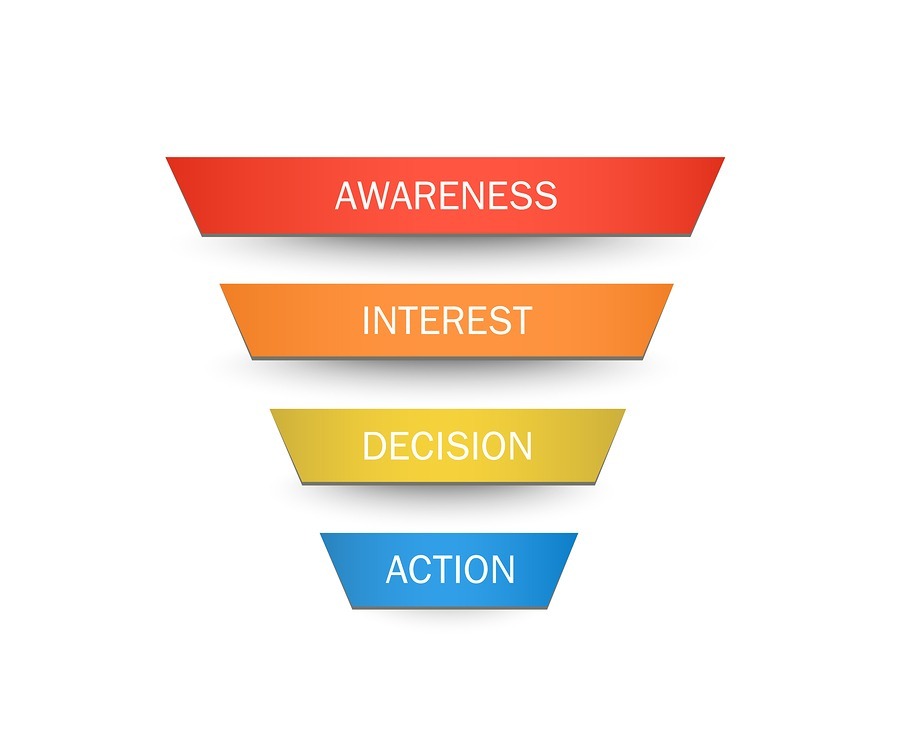
At the top of the funnel, the consumer doesn’t know anything about your brand yet. He or she just stumbles across your website or social media profile and finds you interesting. It’s your job to capture that consumer’s attention.
If you’re successful, the prospect becomes interested in what you sell. He or she might compare your products against those of your competitors, seek out reviews from third-party sources, and even ask their social circle about your brand.
Next comes the decision. Your prospect weighs the pros and cons of buying from you, taking into account factors like questions, objections, pain points, and financial issues. Ideally, the prospect converts into a customer at the action phase.
What is a Sales Funnel Process?
A sales funnel process is a strategy you construct specifically for your business. It maps out your marketing strategy based on the sales funnel and how your customers generally make purchasing decisions.
You can begin to collect data right away so you get to know your customers better. A simple, free tool like Google Analytics can prove extremely valuable.
The goal is to figure out how you’ll nurture your prospects through each stage of the sales funnel. Yours might look something like this:
- Awareness: Use retargeting Facebook Ads, publish great content, optimize content for SEO, get active on social media
- Interest:Invite the user to sign up for your email list, suggest helpful resources, create and distribute a lead magnet
- Decision: Send a coupon code, discount, or other incentivizing offer to convince your prospect to convert
- Action: Upsell and cross-sell to your customer by suggesting related products or product bundles
Every sales funnel process is built around the target audience. Once you know what your market wants, you can deliver it.
How to Find Sales Funnel Opportunities
If you’re not already intimately familiar with your audience, you need to start collecting data. In many cases, this means having conversations with people who fall into your target market.
It might sound scary, but it’s the easiest way to figure out how to reach the people who are most likely to buy your products. Once you have the information, you can create a sales funnel around it.
Social Media
Social media polls and surveys work extremely well. Ask a series of very specific questions and invite people to lend their opinions. You might be surprised how many of your followers participate.
You’re looking for information about what influences their buying decisions and what pain points or complications they face related to your brand.
If you don’t want to host a poll or survey, consider starting or joining a Facebook Group. Give it a theme that’s related to your target audience, then converse with people naturally. You can collect lots of valuable information that way.
Forums
You can also collect valuable data in industry-related forums. Don’t join and participate as a marketer. Instead, blend into the crowd. Ask and answer questions naturally and participate in the existing discussions.
You might want to browse through the forum archives, too. Even older posts can pass along nuggets of information you can use to reach your audience.
Google Trends
Another great strategy is to use Google Trends to figure out what’s hot in online conversations and searches right now. You can figure out the best keywords to target in your content marketing, for example, and which products to push at what time.
If I have an ecommerce store that sells fitness equipment, I might want to check Google Trends for keywords like “dumbbell.”
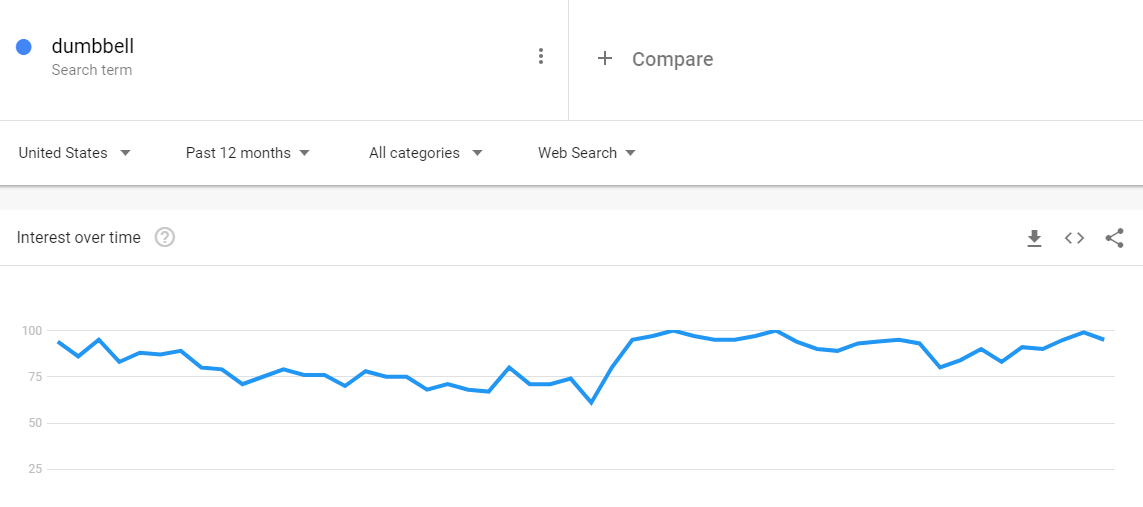
It shows me how interest has waxed and waned over time so I can decide whether it’s a keyword worth targeting.
11 Proven-to-Work Tips on How to Create a Profitable Sales Funnel
Learning how to create a sales funnel isn’t the most challenging thing you’ll ever do, but it does require some guesswork and testing. And it helps if you know what has worked for other brands in the past.
I’ve come up with 11 tips on how to create a sales funnel that I know will work for you because they’ve worked for me.
1. Create a Valuable Lead Magnet For Your Audience
A lead magnet allows you to incentivize email signups so you gather more leads for your business. Remember that the sales funnel starts with a wide brim. You want to pour as many leads into the funnel as possible because they won’t all convert.
Most people won’t hand over their email addresses unless there’s something in it for them. It’s hard to blame consumers, considering that most of us are inundated with email on a daily basis. We don’t want to add more messages to our inboxes.
To create a valuable lead magnet, you have to ask yourself three critical questions.
What Does Your Audience Want?
A lead magnet can’t just be something you throw together in an afternoon. It needs to deliver true value.
Figure out your audience’s pain points, desires, and needs. What are they interested in? How can you help them solve a very specific problem or reach a desirable goal?
For instance, if you’re selling fitness equipment, you could create a checklist for people who want to start running marathons. It can include everything the reader needs to accomplish in the days, weeks, and months leading up to that first marathon.
What Are Your Competitors Doing?
Spying on your competitors is never a bad thing. You want to know what they’re up to at all times so you can steal their customers and make more money.
Check out their lead magnets to see what they’re offering. Make a list of your top 20 or 30 competitors in a spreadsheet, then list the lead magnets next to them. Download those lead magnets by signing up for their email lists, then comb through them carefully.
What are they missing? How are they leaving money on the table by providing substandard value?
Which brings me to my final question…
Can You Outperform Your Competitors?
Your lead magnet has to better than anything your competitors offer. If one company offers a 100-page ebook on a topic, your lead magnet might be a 200-page ebook on a broader topic.
Focus on delivering more value for free. It’s painful to give away information — believe me, I know — but it’s best for your business in the long run. If consumers view your business as generous, they’ll be more likely to feel comfortable spending money in your online store.
2. Promote Your Lead Magnet to Your Audience
Once you’ve created a value-packed lead magnet, your audience needs to hear about it. Otherwise, how will they know to sign up?
Use Hello Bar to create a top bar for every page of your website except the signup page.
![]()
Create at least two versions of your top bar so you can A/B test them. For instance, you might use the top bar above, then test it against this one:
![]()
In this example, I’ve changed just one element: the call to action. You can run subsequent A/B tests for the headline, colors, fonts, and more.
3. Create a Lead Capture Page to Get Emails In Exchange for Your Valuable Lead Magnet
Once you’ve created your top bar with Hello Bar, you need a destination page. This is called a lead capture page, and it’s designed to boost your lead generation efforts.
Here’s a prime example from Cabot Creamery:
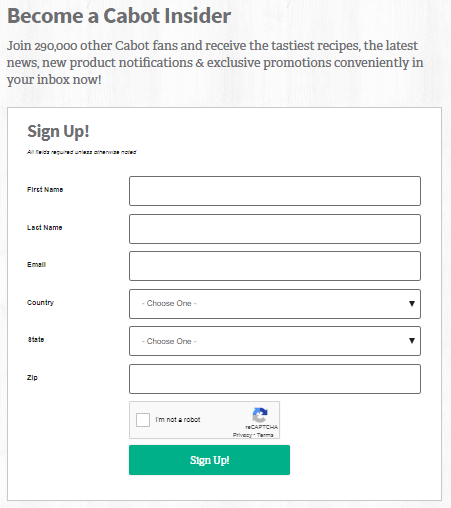
I might change a few things about this lead capture page, such as reducing the number of form fields, eliminating the Captcha, and sprucing up the CTA, but I love the headline and body text. It’s welcoming and uses social proof to convince people to sign up.
4. Create an Automated Email Drip Campaign to Nurture Your New Leads With Valuable Information
When you create a sales funnel, email collection is just the beginning. Now you want to start engaging with your leads so they feel comfortable with your brand and start to think about your products or services.
Email drip campaigns offer the ideal opportunity to make sure you stay in regular contact. A drip campaign involves sending out a series of pre-written emails on a regular schedule. You could send emails once a day or once a week — test different time frames to see what works best.
Why Nurturing Leads is an Important Step in Your Conversion Funnel
Email drip campaigns and other aspects of top-of-funnel marketing are all part of lead nurturing. Think of it as caring for an infant.
A baby is completely dependent upon you for everything he needs, from food to water to shelter. As he grows up, you teach him new things and help him make smart decisions.
This doesn’t mean you should infantilize your subscribers. However, nurturing them toward the desired outcome can result in increased conversions.
Tips To Craft a Content Plan For Your Sales Funnel
You need great copywriting skills (or a great copywriter on staff) to survive in today’s business environment. Content reigns supreme as the easiest and most accessible way to reach your target audience.
It’s not all about email, either. Are you posting on your blog and social media? If not, you should be.
Create a content plan based around your target audience’s pain points, wants, and needs. From there, decide how you’ll promote your content for maximum conversions.
5. Offer Your Leads a Tripwire Offer
It sounds a little bit underhanded, doesn’t it? A tripwire offer isn’t sinister at all, though. It’s a legitimate marketing tactic that can help usher leads through the sales funnel faster.
What is a Tripwire Offer?
A tripwire offer is a low-cost, low-friction offer for your audience. It’s kind of like asking music lovers to buy a single song on iTunes for $0.99 instead of the entire album. From there, you upsell your customers on more expensive products.
If the customer likes one of your songs, for instance, he or she might decide to invest in the whole album. At that point, you’ve increased your customer base as well as your revenue.
Why a Tripwire Offer is a Very Important Step for Your Sales Funnel
A tripwire offer turns your lead into a customer. It’s a conversion. Once someone has bought something from you in the past, they’re far more likely to buy from you in the future.
In part, it’s because you have an established relationship.
Additionally, tripwire offers give you the chance to prove your mettle. In other words, it’s a bit of a test. If you let down your customer, he or she probably won’t come back. If you knock it out of the park, on the other hand, you might gain a loyal customer.
Tripwire offers don’t have to involve physical products. It could be a webinar where you teach insider tips in your industry.
6. Keep Providing Valuable Content — But Start Start Informing Your Audience About Your Core Offer
It’s important not to rush your audience. What do I mean by that?
Imagine walking into a brick-and-mortar store. You’re just starting to look around when a salesperson rushes you with a product in hand, steers you toward the checkout counter, and demands you buy the product.
That’s a pretty negative experience, right?
Keep that image in your mind when you’re warming up your audience. Give plenty of value before you start asking for the purchase.
You can mention your core offer, but don’t use salesy language. Focus on informing your subscribers and audience for now.
What is a Core Offer?
Your core offer is the action you want your audience to take. It might be your best-selling product or your top-of-the-line service. Maybe it’s a product bundle or a subscription.
Whatever the case, it’s the offer that best aligns with your audience’s pain points, wants, and needs. You might segment your audience into several groups so you can present them with their own unique core offers.
7. “Launch” Your Core Offer to Your Warmed Audience
Now that you’ve warmed up your offer, make your pitch. It should be short, sweet, and packed with valuable information.
Let’s say you’re selling fitness gear and you want your core offer to be a set of workout equipment.
Your email might look something like this:
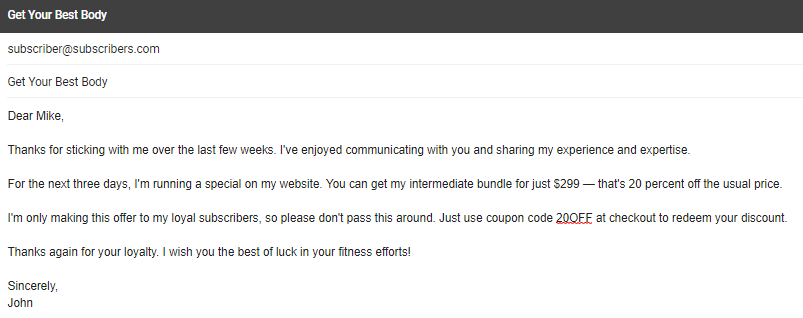
This is just a plain-text example I cooked up, but you get the point. Make your subscribers feel appreciated while offering them a discount and thanking them for reading your emails.
8. Create Email Campaigns to Re Engage Leads Who Didn’t Reach the End of the Funnel
Many of your subscribers won’t convert on the first try. That’s okay. You can create a new email campaign to bring them back into the funnel and try again.
At this point, you might ask them directly why they weren’t interested in your offer. It’s a great way to get feedback. Even if you don’t, mention that you’re sorry they didn’t take advantage of your discount (or other offer), and that you’re excited to stay in communication.
9. Constantly Test and Measure Your Conversion Funnel Results to Reach More People
I test everything. If I rely exclusively on assumptions, I probably won’t get my desired results.
For instance, I use tools like Google Analytics, Crazy Egg, and Ubersuggest to get more value out of every marketing decision I make. They’re essential to building my own business and helping my clients succeed.
But what exactly do you need to test?
A/B Test Your Calls to Actions
CTAs are fickle beasts. They don’t always work the way you intended.
If you’re a Hello Bar subscriber, you can automatically A/B test two variations of your CTAs. We’ll give you the results as soon as we have enough data to make a determination.
Use Google Analytics to Get Valuable Data
Google Analytics is great when you need a free product to help generate data. It doesn’t come with as many bells and whistles as the paid tools, but it’s enough to help you make decisions.
For instance, pay careful attention to your user flow report.
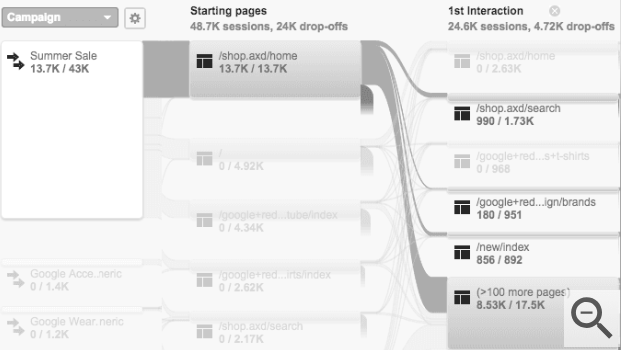
It tells you where people land on your site and how they navigate through your site. Plus, you can run user flow reports for specific campaigns to get even more granular data.
10. Keep Repeating This Process Using Data From Your Tests to Constantly Improve Your Sales Funnel
It might seem a little monotonous, but you can’t ever stop testing. Your audience will evolve and so will your business, so you have to be ready to adapt at a moment’s notice.
You’ll create more products, expand your services, tap into a new user base — whatever. These changes will require you to reimagine your sales funnel so you can reach people more effectively.
11. Do Not Forget to Keep in Touch and Offer Value for People Who Went Completely Through Your Sales Funnel
Customer acquisition is essential, especially when you’re first starting your business. However, customer retention is even more important.
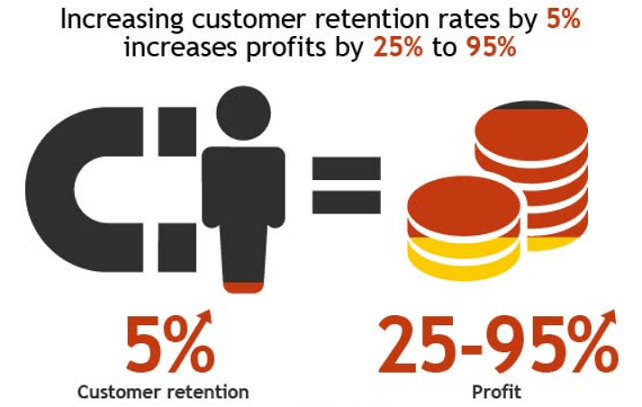
If you can keep your customers firmly in the buyer’s cycle, they’ll come back for future purchases again and again. That’s a great sign that your marketing campaign is working well.
Plus, you can create a sales funnel specifically for repeat customers. Figure out how to keep them engaged instead of bored.
Post-Purchase Customer Nurturing Tips
After someone makes a purchase, you might send them a coupon code for the next purchase. You could also offer something for free, such as a lead magnet, and share with them insider information about products in development.
In other words, make them part of your brand.
Conclusion
If you put your sales funnel to work, you’ll be amazed at the results. The more you learn about your audience and apply that data to your funnel, the more conversions you’ll get.
It’s not easy, but it’s profitable. Plus, who said running a business was easy?
Fortunately, you’ll get better at managing your sales funnel the longer you work with it. And you’ll get plenty of practice because you need a separate sales funnel for each of your buyer personas.
What’s your favorite trick for optimizing a sales funnel?

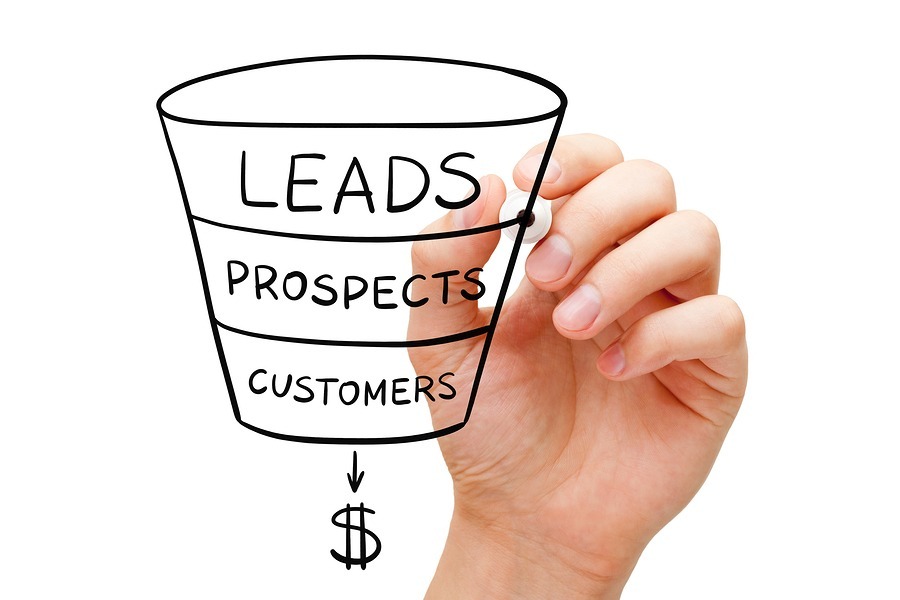
Very nice post and also very helpful too. thank you for the post.
Bangla Eid SMS 2018
This is a really good tip especially to those fresh to the blogosphere.
Short but very precise info… Appreciate your sharing this one.
A must read article!